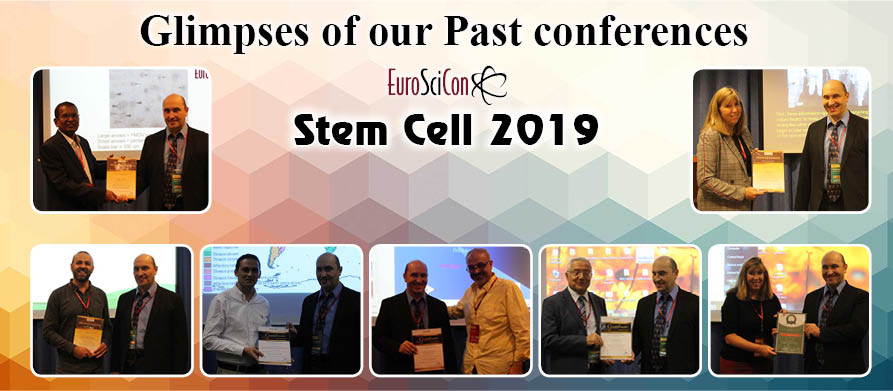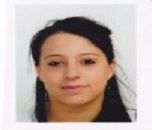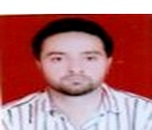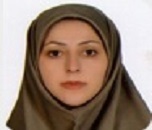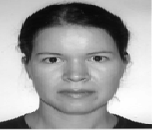Stem Cell 2020
About Conference
Theme: Frontiers in Stem Cells & Turning Ideas in to Reality
The Euroscicon is going to organize Stem Cell Conferences which scheduled from June 25-26, 2021 in London, UK and focusing on the present and future technologies in Stem Cell. The theme of this year’s meeting is “Frontiers in Stem Cells & Turning Ideas in to Reality”. Stem Cell 2021 conference aim is to provide the recent research topics where all the participants would get the opportunity to discuss the latest developments in the field of Stem Cell and Regenerative Medicine as well. Current studies of Stem cell are examining how undifferentiated organisms might be utilized to anticipate or fix sicknesses and wounds, for example, Parkinson's illness, type 1 diabetes, coronary illness, spinal string damage, strong dystrophy, Alzheimer's malady, strokes, osteoarthritis, and vision and hearing misfortune. Immature microorganisms could likewise be utilized to supplant or repair tissue harmed by ailment or damage.
What is New?
Stem Cell congress includes international attendee workshops, lectures and symposia, including a designated registration area, a respite and regalement. Stem Cell educators can join the EuroSciCon as an international member to receive discounts on registration. So come and join leading experts and allied professionals from June 25-26, 2021 in London, UK to keep up with the rapidly accelerating pace of change that is already having an impact on the field of Stem cell, and will continue to in the future.
About London
London, the capital of England and the United Kingdom, is a 21st-century city with history stretching back to Roman times. At its centre stand the imposing Houses of Parliament, the iconic ‘Big Ben’ clock tower and Westminster Abbey, site of British monarch coronations. Across the Thames River, the London Eye observation wheel provides panoramic views of the South Bank cultural complex, and the entire city.
Sessions and Tracks
TRACK 1: STEM CELLS - AN INSIGHT
Stem Cells are uniform cells found in cell living beings that separate through cell division and separate into particular cells. The two traditional properties of foundational microorganisms which grant them to separate into almost any very body cell are self-restoration and proficiency. Because of their potential job in different treatments, a foundational microorganism is a subject of inside and out examination of Extensive Research Science.
- Biology of Human Embryonic Stem Cells.
- Genomics and Genetics in Somatic Cell Biology
- Cell signal in Somatic Cell Differentiation.
- In-vitro culturing of Stem Cells.
- Applications of Somatic Stem Cells.
TRACK 2: CANCER STEM CELLS
Cancer Stem Cells (CSCs) are the sure godlike cells inside the tumor or hematological districts that have attributes identified with the ordinary undifferentiated cell and they are fit for multiplying into every other kind of disease cells Cancer Immature Microorganisms explicitly have a capacity to offer ascent to all cell types found in a specific malignancy test. Malignancy foundational microorganisms are the essential focuses of disease scientist and oncologist for treatment of different tumors, despite the fact that they are genuinely impervious to chemotherapy and radiotherapy. These cells offer ascent to new tumors by metastasis and backslide brought about by estimating the foundational microorganisms to endure in tumors as an unmistakable populace. Methodologies have been made to abuse the property of these phones to create interminable cell lines for the generation of medications and cytokines pertinent to restorative use, at the same time, significantly all the more understanding is required before acquiring the outcomes practice.
- Breast Cancer Stem Cells (BCSCs)
- Signalling in Tumorigenic Cells
- Diagnostic and Prognostic Biomarkers of Cancer Stem Cells
- Drug Resistance in Cancer Stem Cells
- Cancer Antigens as Immunotherapy Targets
- Pharmaceutical Applications of Cancer Stem Cells
- Stem Cells in Cancer Treatment
TRACK 3: BIO-MAKERS OF CANCER STEM CELLS
Liver cancer is the fifth most normally analysed harm and the second most incessant reason for cancer death in men around the world. Amongst liver cancers, Hepatocellular Carcinoma (HCC) represents the major histological subtype and it is one of the most common malignant human tumours worldwide. Research into the molecular biology of hepato-carcinogenesis has identified several biomarkers, which could provide additional information in order to better understand the biology of HCC. Marks of a mix of biomarkers might be more important for the finding, arranging and visualization of HCC.
- RAPD
- Transciptomic Biomarkers
- Proteomic Biomarkers
- RFLP
TRACK 4: STEM CELL BIOLOGY & ADVANCES
Structural microorganisms have the amazing potential to form into a wide range of cell types, basically divided to recharge different cells as long as the individual or creature is as yet alive, offering gigantic any expectation of relieving Alzheimer's infection, fixing harmed spinal lines, treating kidney, liver and lung maladies and making harmed hearts entirety. Up to this point, researchers essentially worked with two sorts of undifferentiated organisms from creatures and people: embryonic foundational microorganisms and non-embryonic "physical" or "grown-up" undeveloped cells. Late leap forward make it conceivable to change over or "reconstruct" specific grown-up cells to expect a stem cells with various innovations. The audit will quickly talk about the on-going advances here.
- Stem Cells in Endocrinology
- Liver Stem Cells and Regeneration
- Early Embryonic Development
- Neural Stem Cells and Regeneration
- Blood Stem Cells and Regeneration
- Muscle (cardiac and skeletal) Stem Cells and Regeneration
- Totipotency, Pluripotency and Multipotency
TRACK 5: ADVANCED IN TISSUE REGENERATION
Tissue Engineering is a logical field and furthermore portrayed as understanding the benchmarks of tissue and its improvement by handy exchange of insufficient tissue for clinical use. Tissue building bargains about the investigation of mix of cells, structuring, materials methodologies, hemispherical and biochemical segments to supplant or upgrade characteristic tissues. Tissue Engineering includes the utilization of Scaffolds to shape practical tissues and organs, which can be embedded, again into the benefactor, have with the utilization of many building and materials techniques alongside some hemispherical elements. It is identified with in excess of one branch which applies building information and life science ideas towards the advancement of natural substitutes which can enhance or re-establish physiological qualities of organ.
- Tissue Engineering
- Regenerative Medicine
- Bio Materials
- Scaffolds
- Tissue Regeneration
TRACK 6: EMBRYONIC STEM CELL
Embryonic Stem Cells are pluripotent, which implies they can produce (i.e. partitioned) into all auxiliaries of the three germ layers: ectoderm, endoderm and mesoderm. By the day's end, they can shape into each one of the more than 200 cell sorts of the adult body as long as they are resolved to do all things considered. Embryonic microorganisms are perceived by two absolute properties: their pluripotency, and their ability to repeat tentatively. These consolidate each one of the more than 220 cell writes in the adult body. Pluripotency perceives embryonic stem cell from grown-up juvenile microorganisms found in adults; while embryonic primary microorganisms can make all cell creates in the body, grown-up undeveloped cells are multipotent and can convey only a set number of cell composes. Besides, under described conditions, embryonic youthful microorganisms are prepared for multiplying themselves uncertainly. This empowers embryonic undifferentiated life forms to be used as supportive instruments for both research and regenerative pharmaceutical, since they can make unlimited amounts of themselves for continued with examine or clinical use.
- Embryonic Stem Cell
- Embryonic Stem Cell Research
- Pro embryonic Stem Cell Research
- Human Embryonic Stem Cells
TRACK 7: REPROGRAMMING IN STEM CELL & TRANSPLANTATION
Transplantation is that the novel approach of transferring cells and tissues, in addition as organs kind Donor to recipient to revive the perform of the required organ, tissue and cells. There area unit many procedure area unit there autologous (self), allogeneic (person to person), organ transplant (species to species). There are unit many transplantation area unit there that area unit with success approached in humans. Bone marrow transplantation is that the commonest technique used to treat various number of diseases together with Cancer. Rather than that analysis area unit occurring within the method of reprogramming the pluripotent vegetative cell to organic process cell will which is ready to be able to treat many diseases can describe disease models and induce a replacement hope within the field of Transplantation.
- Autologous Vegetative Cell Transplant
- Allogeneic Vegetative Cell Transplant
- Organ Transplant
- Syngeneic Vegetative Cell Transplant
- Half-Matched (haploidentical) Transplants
- Graft-Versus-Cancer
- Organic Process StemCell/Blood-Forming Transplantation (HSCT)
- Tissue and Surgical Procedure
TRACK 8: TREATMENT OF DISEASES BY STEM CELL THERAPEUTICS
Stem Cell Therapy is aimed at treating numerous degenerative, hematopoietic and neuromuscular disorders, nearly 80 in number which cannot be treated with conventional methods. Bone marrow transplantation for blood disorders like, leukemia is the most celebrated application of stemcell therapy, other than skin tissue grafting and implantation. This new approach in medical biology is willing at maximizing the quality of life by reducing the adversities of chronic disorders such as cancer and genetic diseases.
- Myelogenous or Lymphocytic Leukemia
- SCID-X1 Stem Cell Therapy
- Type-I Diabetes and Artificial Pancreas
- Neurodegenerative Disorders
- Cardiovascular Diseases
- Autoimmune Diseases
- Spinal Cord Trauma
TRACK 9: STEM CELL BANKING
Umbilicalcord blood is highly enriched with pluripotent stem cells which are considered lifesaving in later stages of life as they can treat a host of disorders. Cord blood stem cells are used to target blood disorders, immune deficiencies, and rare metabolic disorders, including leukaemia, Krabbe disease, aplastic anaemia, non-Hodgkin’s lymphoma and Hodgkin’s lymphoma, sickle-cell anaemia and thalassemia, with least chances of rejection by the body. Cord blood preservation of newborn babies, also termed as, stem cell banking, in public or family banks, is gaining a lot of awareness among people as it holds promise for future well-being.
- Global Market For Cord Blood Preservation
- Clinical Application Of Stem Cell Banking
- Legal Policies And Regulations
- Ethical Issues In Cord Blood Banking
TRACK 10: NOVEL STEM CELL THERAPY
In this stem cell therapy, regenerative medicine, researchers study how stem cells may be used to replace, repair, reprogram or renew your diseased cells. Stem cells are able to grow and develop into many different types of cells in your body. Stem Cell Therapy may use adult cells that have been genetically reprogrammed in the laboratory (induced pluripotent stem cells), your own adult stem cells that have been reprogrammed or cells developed from an embryo (embryonic stem cells).
- Novel Stem Cell Therapy For Knees
- Novel Stem Cell Therapy For Arthritis
- Novel Stem Cell Therapy For Cancer
- Novel Stem Cell Therapy For Hairloss
Track 11: APPLICATION OF STEM CELL IN MEDICINE
Undifferentiated organism treatments convey gigantic potential for treating various human infections. Anyway the interest for contributor's organs exceeds the accessibility by gigantic extents. Another ordinarily confronted test of organ transplants is the occurrence of dismissal because of the beneficiary's insusceptible framework. The utilization of foundational microorganisms for producing tissues and organ unites holds colossal guarantee to satisfy the generally neglected requirement for organ transplants and to enhance the personal satisfaction for many patients.
Foundational microorganism can be coordinated to produce particular cell composes and can be utilized to supplant weak or worsening tissues. The best preferred standpoint of this method is that it beats join to have incongruence. Such tissues are created from the patient's own undifferentiated cells. Consequently, the odds of unite dismissal by the host's resistant framework diminish fundamentally. Immature microorganisms have been utilized in the treatment of spinal string wounds, stroke, and consume, diabetes, cardiovascular illnesses, osteoarthritis, rheumatoid joint pain and so on.
- Stem Cells in the treatment of Cardiovascular Diseases
- Stem Cells in Bone Regeneration
- Stem Cells in the Treatment of Eyesight
- Stem Cells in the Treatment of Diabetes
- Stem Cells in the Treatment of Neurodegenerative Disorders
- Stem Cells in Wound Healing
Track 12: STEM CELL IN DRUG DEVELOPMENT
Undifferentiated cell treatment has opened another road in the territory of medication disclosure and improvement. Biopharmaceutical organizations have been working in interpreting fundamental utilizations of undifferentiated cell advances in the medication improvement forms in order to diminish the high weakening rate generally arrange sedate applicants, which has been developing at a quick pace in the previous decade. Approach of immature microorganism advances has given new prospects to fabricate imaginative cell models. The always developing systems utilized for detachment of human/creature embryonic foundational microorganisms (ESCs), bone marrow-determined mesenchymal undeveloped cells, umbilical line undifferentiated organisms, grown-up tissue-particular neural immature microorganisms and human instigated pluripotent foundational microorganisms (iPSC) have prompted the headway of various high throughput and combinatorial screening advancements consequently supplementing the part of undifferentiated organism models in sedate disclosure.
- Cancer Clinical Trails
- Clinical Research And Bioethics
- Drug Screening Tools
- Stem Cell Biology And Regenerative Medicine
- Drug Safety And Regulations
TRACK 13: STEM CELLS FOR ORGAN REPAIR
It has been expressed that undifferentiated cells have a capacity to create a substantial number of cells which thusly helps in shaping the devastated tissue or an organ. Conversely, undeveloped cells can likewise be helped in repairingthe harmed organs, in which the instrument does in two unique choices: bolster component and supplant alternative. The help instrument of the undeveloped cell is recovery or the regrowth of the tissue or organ cells keeping away from inconvenient fibrosis. The supplant alternative of the stem cellis to transplant the foundational microorganism.
- The Seeds Of Regeneration
- Cell Transplantation Therapy
- Stem Cells To Liver Tissues
- Stem Cell Exosomes
- Hematopoietic Stem Cell Homing
- Mesenchymal Stem Cells: Harnessing Cell Plasticity
TRACK 14: STEM CELL APOPTOSIS & SIGNAL TRANSDUCTION
Apoptosis, a molecularly directed type of cell passing, is basic for the typical working and homeostasis of most multicellular creatures. Apoptosis is directed by a portion of a similar flag transduction pathways already embroiled in other physiological cell reactions. Self-recharging and multiplication of immature microorganism populace are controlled by Apoptosis. Apoptosis of undeveloped cells is accepted to be a dynamic procedure which changes in light of natural conditions. Controlling apoptosis is additionally an imperative concentration for investigations of foundational microorganism transplantation. Abusing the full remedial capability of undifferentiated cells will require full translation of the flag transduction torrential slides for expansion, separation, and apoptosis.
- Ubiquitination Pathways
- Cell Signalling In Stem Cells
- Cellular Proliferation And Tumor Growth
- Cellular Senescence And Pathways In Aging
- Molecular & Genomics Analysis Of Cancer
- Cancer Stem Cells And Impaired Apoptosis
- Apoptosis Transcription Factors And Regulators
TRACK 15: ETHICAL ISSUES IN STEM CELL RESEARCH
Advance in biotechnology has presented a large group of squeezing moral and approach issues relating to undifferentiated cell investigate. Undifferentiated organism explore offers extraordinary guarantee for understanding fundamental instruments of human improvement and separation. The direction of undifferentiated cell explore is an issue that has drawn much remark, feedback and even legal assertion as of late.
- Cord Blood Stem cells
- Adult Blood Stem cells
- Existing Embryonic Stem Cell Lines
TRACK 16: NANOTECHNOLOGY IN STEM CELLS
In recent years, the inter crossing of nanotechnology in stem cell biology and biomedicine has led to an emerging new research field, known as stem cell nanotechnology. Stem cell nanotechnology is defined as the application of nanotechnology in stem cells research and development, and it is characterized as highly rapid in development, highly interdisciplinary, and highly controversial.
- Nanoparticles: Cell Tracking, And Endocytosis
- Imaging Methods And Technologies
- Nanovaccines
- Nanomaterials And Nanoengineering
- Nanotechnology For Genetic Engineering
- Nanotechnology For Creating Stem Cell Niche
- Nanoparticle Toxicity To Stem Cells
TRACK 17: STEM CELL & TISSUE HOMEOSTASIS
Tissue homeostasis depends upon the accurate direction of substantial foundation microorganism movement. Consequential undeveloped cells need to react to tissue harm and multiply as per tissue essential, while staying away from over-multiplication. The administrative systems engaged with these reactions are presently being disentangled in the intestinal epithelium of Philosophical, giving new understanding into procedures and components of undeveloped cell direction in obstruction epithelial.
- Scs And Their Niches
- Hematopoietic Scs
- Scs And The Origin Of Intestinal Cancer
TRACK 18: ETHICS CONSIDERATION IN STEM CELL THERAPY
Stem Cell Research offers incredible knowledge for understanding fundamental components of human advancement and separation, and additionally the expectation for new medications for illnesses, for example, diabetes, spinal line damage, Parkinson's ailment, and myocardial localized necrosis. In any case, human Stem Cell (hSC) inquires about additionally raises sharp moral and political contentions. The reconstructing of substantial cells to deliver instigated pluripotent undifferentiated organisms keeps away from the moral issues particular to embryonic microorganism examine. These moral and strategy issues should be talked about alongside logical difficulties to guarantee that undeveloped cell examine is done in a morally suitable way. This article gives a basic investigation of these issues and how they are tended to in current approaches.
- Multi-Potent Stem Cells
- Embryonic Stem Cell Research
- Somatic Cell Nuclear Transfer (SCNT)
- Induced Pluripotent Stem Cells (Ips Cells)
- Stem Cell Clinical Trials
TRACK 19: EPIDERM STEM CELLS & CANCER EPIDEMOLOGY
The skin continually re-establishes itself for the duration of grown-up life, and the hair follicle experiences an interminable cycle of development and degeneration. Microorganisms (StemCell's) dwelling in the epidermis and hair follicle guarantee the support of grown-up skin homeostasis and hair recovery; however they likewise take part in the fix of the epidermis after wounds.
- Stem Cells With In Adult Skin Epithelium
- Signalling And Stem Cell Fate Specification In The Skin
- Bone Morphogenetic Protein Signalling
- Notch Signalling
TRACK 20: STEM CELLS IN CARDIOVASCULAR DISEASES
CardiovascularDiseases (CVD) includes hypertension, coronary artery disease, stroke and congestive heart failure. Most of these disorders occurred by less oxygen supply to heart cells / Cardiomyocytes which damaged as being supplied by less oxygen as well as less blood which can be treated by stem cell therapy by inducing some bone-marrow derived mononuclear cells, umbilical cord blood cells, Mesenchymal stem cells or Cardiac stem cells in to the damaged portion of heart . These cells integrated in to heart and secrete certain proteins and paracrine factors that repair of the damaged area by cardiac tissue Regeneration.
- LQT Syndromes
- Timothy Syndrome
- LEOPARD Syndrome
- Duchenne Muscular Dystrophy (DMD)
- Becker Muscular Dystrophy (BMD)
- Hutchinson Gilford Progeria (HGPS)
Stem Cell Market Analysis
Globally Regenerative Medicines market size is predicted to reach USD 30,237 million by 2022. Recently, Regenerative Medicine has emerged with full of promise approaches to treat and cure complex degenerative disorder and to support, restore the function of tissues and cells in other therapies. North America leads the way of a global market in 2015 and it is expected to remain ascendant during 2015-2022. Stem Cells are used to treat cancer and different immune system diseases. And now Stem Cells are suspected for the treatment in Neurodegenerative Diseases, wound healing, spinal cord injury, etc. The worldwide Stem cell & regenerative medicines market is divided according to product type, application, sources, geography and end users. By the product type stem cells market is again divided into human embryonic stem cells, adult stem cells, IPsec’s, etc. Whereas, regenerative medicines have the capability to regenerate, repair & replace tissues of the organ which are affected due to injury, natural aging process, and some diseases. These medicines are able to restore the performance of cells & tissues, therefore, now researchers are focusing on the new technologies which are basically based on biologics, genes, somatic and stem cells as well. The proliferation and differentiation is the major capability of stem cells owing to which they are of importance in this field. Utilization of Nano-materials in immunomodulation, drug delivery, and wound care make the growth the avenues for the regenerative medicines market.
The regenerative medicine market is broadly divided into three categories namely biologically derived materials, synthetic materials, and genetically engineered materials. The Synthetic materials and biologically derived materials have high demands in the market due to its higher efficiency as compared to other naturally derived materials.
Raw Material Analysis:
For biologically derived materials for regenerative medicines, demand is higher compared to other naturally derived materials due to its efficiency. The procedures say synthetic materials have used hydrogel in tissue engineered scaffolds. This report provides a complete overview of the growth rate of regenerative medicines and stem cells. It is believed that the stem cell market will grow appreciably. Regenerative medicine is a wider field which encompasses the potential to acquire its achievement. Financially, investment in this field is all by grants, private inventors, and publicly traded stocks. Looking ahead, the regenerative medicine and stem cells market is promising for a number of powerful reasons including.
Stem Cell-A new opportunity in Cosmeceuticals Market:
The market was evaluated at $42.24 billion in 2016 and is expected to reach a value of $68.72 billion by 2022, witnessing a CAGR of 8.52% during the predicted period, 2017-2022.
Cosmeceuticals are the emerging market and so there are lots of opportunities lies in the market that is needed to be explored. North America has been declared as the second largest in the market of cosmeceuticals that has estimated for a share of 31% approx. in 2016.
The United States is the major industry for the organic and in North America natural cosmetic products which shares 85% approx. in 2016 with a market value of $10.62 billion. Whereas, the Asia Pacific is the third largest industry for skin care products market which estimated a share of 22% approx. in 2016.
Global Market Study of Stem Cells & Regenerative Medicine:
USA: The regenerative medicine & stem cell market is assuming to reach $38.70 billion by the year 2022 from $ 13.33 billion in 2016 at a CAGR of 23.56%.
Europe: The regenerative medicine & stem cells market is expected to reach USD 13.578 billion by 2022 from USD 5.06 billion in 2016 at a CAGR of 21.80% during the period 2016-2022.
Middle East: The regenerative medicines market is expected $ 40.55 billion revenue in 2022 from $ 17.03 billion revenue in 2016.
Learn More
Top Universities for Stem Cell in Japan:
University of Edinburgh| University of Cambridge | University of Oxford | Karolinska Institute | University College London | University of Copenhagen | Imperial College London | University of Munich | King's College London | Pierre and Marie Curie University | Leiden University | University of Helsinki | Heidelberg University | Utrecht University | Catholic University of Leuven | Uppsala University | University of Groningen | University of Barcelona | Lund University | Technical University of Munich | Queen Mary, University of London | University of Amsterdam | University of Zurich | University of Manchester| Swiss Federal Institute of Technology Zurich | University of Bristol | University of Glasgow | University of Eastern Finland | University of Leicester| University of Strasbourg | VU University Amsterdam | University of Geneva | University of Oslo | University of Milan
Top Universities for Stem Cell in Asia:
University of Hong Kong (HKU) | Peking University | Seoul National University (SNU) | National Taiwan University (NTU) | Osaka University | Tsinghua University | The Chinese University of Hong Kong (CUHK) | Fudan University | The Hong Kong University of Science and Technology (HKUST) | Taipei Medical University | Mahidol University | KAIST - Korea Advanced Institute of Science and Technology | The University of Tokyo | National University of Singapore (NUS) | Kyoto University | Yonsei University | Shanghohoku University Jiao Tong University | Nanyang Technological University (NTU) | Chulalongkorn University | | Tokyo Medical and Dental University | Kyushu University | Nagoya University | University of Science and Technology of China
Nature Reviews Molecular Cell Biology | Annual Review of Cell and Developmental Biology | Nature Cell Biology | Nature Methods| Cancer Cell | Cell Stem Cell | Molecular Cell | Annual Review of Plant Biology | Annual Review of Biophysics | Cell Metabolism | Trends in Cell Biology | Journal of Cell Biology |Genome Biology | Nature Chemical Biology | Current Opinion in Cell Biology | Plant Cell | Stem Cell Reports | Cell Research | Progress in Lipid Research | Cell Death and Differentiation | Science Signalling | Seminars in Cell and Developmental Biology | Molecular and Cellular Biology | BMC Biology | Plant Journal |Journal of Cell Science | Stem Cells | Aging Cell | Molecular Biology of the Cell | Autophagy| Cellular and Molecular Life Sciences | Current Topics in Developmental Biology | Journal of Molecular Cell Biology | Journal of Biological Chemistry | Antioxidants and Redox Signalling | Biochimica et Biophysica Acta - Molecular Cell Research | Aging | Biochemical Journal | RNA Biology | Skeletal Muscle | Plant and Cell Physiology | Journal of Investigative Dermatology | Journal of Lipid Research | Journal of Leukocyte Biology | Developmental Biology | Biochimica et Biophysica Acta - Bioenergetics


